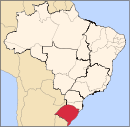You can help expand this article with text translated from the corresponding article in Portuguese. (August 2012) Click for important translation instructions.
|
| Arvorezinha | |
|---|---|
| Municipality | |
 Flag Flag Coat of arms Coat of arms | |
 Within Rio Grande do Sul Within Rio Grande do Sul | |
| Country | Brazil |
| State | Rio Grande do Sul |
| Government | |
| • Prefect | Rogerio Felini Fachinetto (PDT) |
| Area | |
| • Total | 271.643 km (104.882 sq mi) |
| Elevation | 750 m (2,460 ft) |
| Population | |
| • Total | 10,423 |
| • Density | 38/km (99/sq mi) |
| Demonym | arvorezinhense |
| Time zone | UTC−3 (BRT) |
Arvorezinha (Portuguese: [ˌaʁ.vo.ɾiˈzĩ.ɲɐ] ) is a municipality in the state of Rio Grande do Sul, Brazil. It literally means "small tree".
History
The municipality's first inhabitant was Lino Figueira, who settled in the region c. 1900. Much of the incoming population were Italian immigrants from the nearby cities of Antônio Prado, Veranópolis, Bento Gonçalves, Caxias do Sul and Garibaldi, who started settling during the early 20th century. Before its establishment as a municipality, which was official as of February 16, 1959, the land belonged to Taquari and later Encantado.
See also
References
28°53′S 52°10′W / 28.883°S 52.167°W / -28.883; -52.167
 | This geographical article relating to Rio Grande do Sul is a stub. You can help Misplaced Pages by expanding it. |
